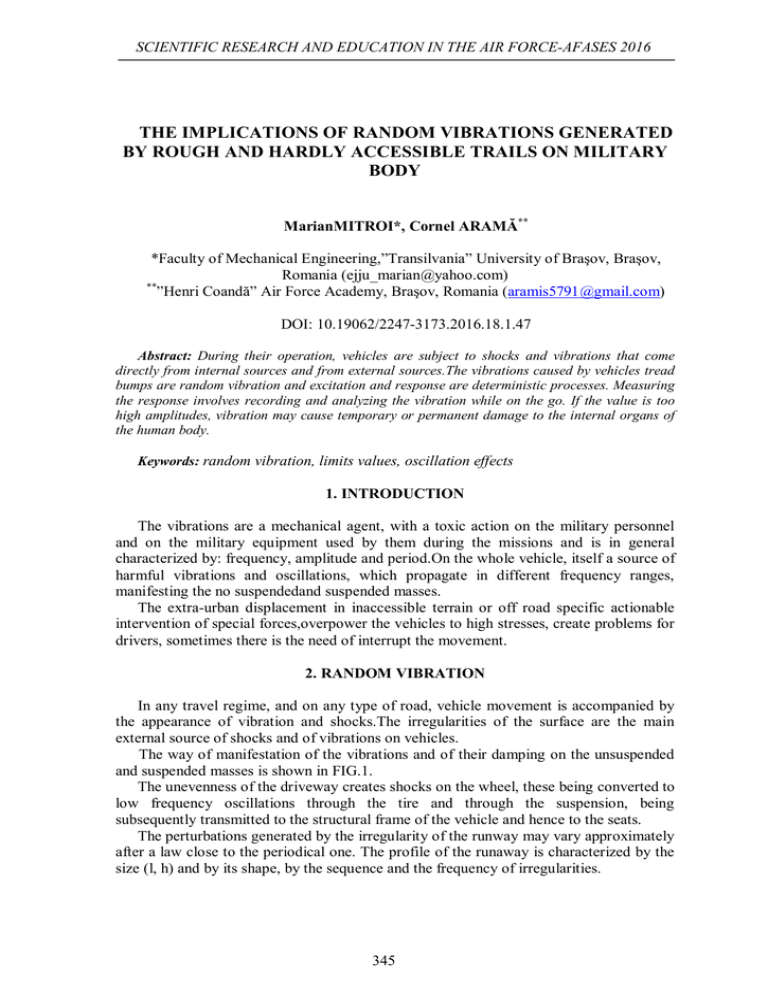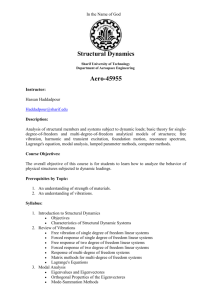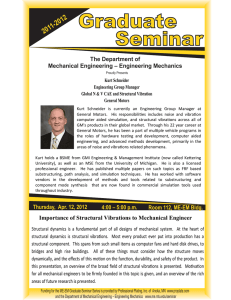the implications of random vibrations generated by rough and hardly
advertisement

SCIENTIFIC RESEARCH AND EDUCATION IN THE AIR FORCE-AFASES 2016 THE IMPLICATIONS OF RANDOM VIBRATIONS GENERATED BY ROUGH AND HARDLY ACCESSIBLE TRAILS ON MILITARY BODY MarianMITROI*, Cornel ARAMĂ** *Faculty of Mechanical Engineering,”Transilvania” University of Braşov, Braşov, Romania (ejju_marian@yahoo.com) ** ”Henri Coandă” Air Force Academy, Braşov, Romania (aramis5791@gmail.com) DOI: 10.19062/2247-3173.2016.18.1.47 Abstract: During their operation, vehicles are subject to shocks and vibrations that come directly from internal sources and from external sources.The vibrations caused by vehicles tread bumps are random vibration and excitation and response are deterministic processes. Measuring the response involves recording and analyzing the vibration while on the go. If the value is too high amplitudes, vibration may cause temporary or permanent damage to the internal organs of the human body. Keywords: random vibration, limits values, oscillation effects 1. INTRODUCTION The vibrations are a mechanical agent, with a toxic action on the military personnel and on the military equipment used by them during the missions and is in general characterized by: frequency, amplitude and period.On the whole vehicle, itself a source of harmful vibrations and oscillations, which propagate in different frequency ranges, manifesting the no suspendedand suspended masses. The extra-urban displacement in inaccessible terrain or off road specific actionable intervention of special forces,overpower the vehicles to high stresses, create problems for drivers, sometimes there is the need of interrupt the movement. 2. RANDOM VIBRATION In any travel regime, and on any type of road, vehicle movement is accompanied by the appearance of vibration and shocks.The irregularities of the surface are the main external source of shocks and of vibrations on vehicles. The way of manifestation of the vibrations and of their damping on the unsuspended and suspended masses is shown in FIG.1. The unevenness of the driveway creates shocks on the wheel, these being converted to low frequency oscillations through the tire and through the suspension, being subsequently transmitted to the structural frame of the vehicle and hence to the seats. The perturbations generated by the irregularity of the runway may vary approximately after a law close to the periodical one. The profile of the runaway is characterized by the size (l, h) and by its shape, by the sequence and the frequency of irregularities. 345 MECHANICAL ENGINEERING. MATERIALS AND TECHNOLOGY FIG. 1.The depreciation’s influence over the suspended and unsuspended masses [1] FIG. 2. The sinusoidal profile of the road and representation of the amplitudes[1] Making a simple analysis of it (FIG. 2), we can see: * If we take into consideration that the irregularities’ profile is sinusoidal, the equation of the runaway profile is of the form: (1) where: the disturbing pulsation; (2) v = the speed of vehicle; l = the length of shading. y = the wave front = A - amplitude; A3 = the maximum positive amplitude; A7 = the maximum negative amplitude. * If the irregularities’ profile is half sinusoidal, the equation of the tread has the form: where :ωt∈ [0, T] (3) However, the road action on road vehicles can be observed based on knowledge of static characteristics of their profiles. There are situations where the tread has a more complicated form and cannot be described by a simple harmonic function, then are use regular functions expressed by Fourier series: (4) where: b0, b1, b2, ..bn = the amplitudes of harmonic components; ω = the angular frequency disturbing. In fact, the interaction between the vehicle’s wheel and the road’s surface has a random profile, the function h (t) can be expressed by the equation: (5) 346 SCIENTIFIC RESEARCH AND EDUCATION IN THE AIR FORCE-AFASES 2016 This mathematical expression allows the characterization of the tread’s action on the vehicle according to its static properties.In the case of such headlands, the main difficulties are related to the rolling resistance force on the wheels’ rotation, which occurs between the contactof the tire with the ground deforming it, and between the multitude of oscillations in different amplitudes, which occur during the displacement. The speed of displacement varies depending on the angle of inclination, on the angle of attack of wheels, and on the present weather conditions. In such circumstances it is necessary the prolonged use of a lowergear, to ensure the dynamic factor which is necessary for certain portions of the road, which generates a forced operating regime of the engine and of the transmission, which contributes to increase the oscillations generated by the assembly tire-wheel and in the same time to increase the level of discomfort for the existing staff in the vehicle. There are situations when the military actions must be conducted suddenly, in a limited time, which requires the acceptance by all participants to the action of a extreme discomfort, where shocks and vibrations transmitted to the body and seats have high values and are even harmful for the human body. [1] 3. LIMIT VALUES OF THE OSCILLATION PARAMETERS During displacements, the discomfort is felt by people in the vehicle when the level of oscillations transmitted by the vehicle’s structure exceeds a certain spectrum frequency and amplitude. The energy of these vibrations is received by the body and subdued, being absorbed by soft tissues and by internal organs to certain values or amplified according to the mechanical laws of vibrations. The man being fragile being, perceives and manifests differently from one person to another when is exposed to shocks and to oscillatory phenomena, the responses of the human body depending on factors such as bone structure and musculature, its dimensions, the frequency of the oscillations and their amplitude, their duration of exposure, the body posture during the analysis etc. The individual perception of the fluctuations is a subjective issue so that, the assessing of the effects of vibration can be given by certain baselines: - The thresholds of perception of oscillations by each individual; - The individual tolerance thresholds oscillations charged; - The bothering thresholds. Exceeding these stages of values causes involuntary and voluntary muscle contractions, local muscle fatigue at the resonance frequency, causes a disorder of the psychological balance etc. The reactions of the human body are psycho-physiological reactions so that in addition to the structure of the individual it is also important his/her familiarity with such perceptions, the age is particularly important, young individuals supporting different oscillatory phenomena compared to the age and also to sex. The resonance system values are different for each part of the system, according to the studies of Rasmussen [4]. The mechanical proposed model for the human body is shown in FIG. 3. According to that system was studied the human body's response to the effect of shocks and oscillations, at different frequencies for standing and seated positions, specific vehicle’s positions. 347 MECHANICAL ENGINEERING. MATERIALS AND TECHNOLOGY FIG. 3. The resonance frequencies of the human body [4] This linear system, with concentrated parameters can be used with greater precision for low frequencies up to 100 Hz, but also for lower levels of vibration. The analysis has shown that in the longitudinal direction, from feet to head, the body is more sensitive to vibrationsfrom 4-8 Hz range, and in transverse directionto those from 1-2 Hz range[4]. Taking into considerationthe running time through some rough terrain, to fulfill the tasks imposed by missions, the travel done in long periods of time, we can understand that the exposures to fluctuations generated by the route are very important and should be carefully evaluated. The forces applied achieve the maximum value within a few tenths of a second, manifested in a very short time, can be called forces applied by shock and usually occur in addressing obstacles appeared suddenly along the runway or after collisions. Any biological system may be influenced by vibrations and shocks, if their amplitude is large enough. The gravity of produced lesions depends on the value of the acceleration taken at the time of the shock’s happening and can occur: bruises, broken bones, concussions and crushing tissue. The pressure generated by the human body on the seat can disrupt the blood’s flow on the body and thighs, and in time, creates permanent damage to soft tissue and capillaries. The pressure of distribution on the seat’s surface is closely related to the weight of the driver and to the curvature of the seat. Thus, the pressure created at the interface seat driver is an important factor which affects the state of comfort and relaxation. In the following image (FIG. 4) are observed the directions of perception of vibrations and shocks through the accelerometer and in the manifestation zone in a seating position. Taking into account the concrete conditions of the military actions, the specific training of individuals and the used equipment, this model can be radically influenced, as follows: - Head - the presence of the protection helmet and of specific equipment; - Pectoral arch – the bulletproof vest collar, the extra weight due to the presence of protection helmet and of accessories and the specific training; - Chest wall - trained body armor and body; 348 SCIENTIFIC RESEARCH AND EDUCATION IN THE AIR FORCE-AFASES 2016 - Abdominal mass - bulletproof vest and specific military training; - Feet – the boots’ presence and the specific training; - Hands – the gloves’ presence, weaponry and specific training; - Backbone - bulletproof vest; - Hearing aid – the presence of ear plugs; - Visual apparatus - the presence of eye protection. FIG. 4. The line expressions of shock in a seated position [1] FIG. 5. The changing military position in the car seat [1] As a result of those mentioned in the preceding paragraph, the model proposed by Rasmussen, in the case of soldiers from special forces who move to interventions, there is required to be modified taking into account the reportedelements. There must be taken into consideration the following conditions, which modify the welfare of the body and the influence of vibration on the militaries’ body: - Long journeys and very dangerous routes, after a certain period of time create an oppressive state on the military, which require them to adopt a more convenient seat position in the chair, but medically incorrect. This incorrect position generates the alteration of the zone and causes cervical spondylosis. The position adopted by the military people during long journeys under the influence of runways’ vibrations and shocks can be seen in Figure 5. 4. THE VIBRATION AND SHOCK’S EFFECTS ON THE HUMAN BODY The human behavior under the action of vibrations is influenced by four important characteristic values: intensity, frequency, direction and duration. To study the response of the human factor to the vibrations’ action upon itself it must be taken into consideration also the mode of their transmission. There are encountered the following situations: - Vibrations transmitted simultaneously to the entire surface of the human body or to a major part of it; - Body vibrations transmitted through aid surfaces (the case of vehicles); - Vibration transmitted through some body parts: head, hands and feet by hand rails or by the systems of action. 349 MECHANICAL ENGINEERING. MATERIALS AND TECHNOLOGY Experiments have shown that the human body due to its anatomical construction tolerates vibrations better in the direct direction than in the lateral one. The sensitivity of the human body is raised from legs to head, to the vibrations in the range of 4-8 Hz, and on the horizontal direction in the frequency range of 1-2 Hz. The attenuation for the vertical position, from toes to the head is 30 dB, and from the body to hands when the steering wheel is used is of 40 dB.[2], [3]. The vibration effects can be seen in various aspects: * the physical effect - occurs due to the direct interfering of the vibration with the physical activity performed by humans, which leads to a reduced performance of certain activities, to hinder some human processes; * the mechanical effect - occurs as a result of exceeding certain limits of propagation and are characterized by the presence of lesions, the most common being those of lung and heart ruptures or the destruction of soft tissues; * the biological effect - occurs due to the stimulation or excitation of the sensorial receptors or of the nervous system and leads to the appearance of fatigue, or to a decreased alertness and of the ability to work, and in some cases to hormonal changes or gastric secretion. This type of effect is also associated with the emotional reactions that lead to behavioral changes of the individuals. When vibrations are propagated vertically, the unpleasant effects are felt to maximum values of the acceleration for: frequencies f <5 Hz, for maximum speeds between 5 Hz <f <40 Hz and for maximum values of displacement f> 40 Hz. Regarding the vibrations propagated horizontally, the strength of the human body is approximately two times lower, their effects being felt to maximum acceleration for: frequencies up to 2 Hz, to maximum speeds for frequencies between 2 and 25 Hz, and in the moment of traveling to f> 25 Hz. [2], [3].The human exposure to vibrations can be measured by the following criteria, depending on the purpose (Figure 6). The vibration exposure limits are set differently, depending on the chosen criteria. The sizes and the acceptable limits used in analyzing the influence of vibrations on the human body have been established for sinusoidal oscillations and in situations of random regimes, the assessment of exposure to vibrationsbeing made using static characteristics, such as the square average, the medium value of the maximum levels for a certain period of time. FIG. 6. The purpose of evaluation of human exposure to vibration [1] 350 SCIENTIFIC RESEARCH AND EDUCATION IN THE AIR FORCE-AFASES 2016 5. CONCLUSION On the human body, the oscillations caused by vehicles have harmful effects, leading to the occurrence of discomfort, fatigue, and in some cases to chronic diseases. The body vibration sensitivity depends on the direction and on nature of the oscillatory movement. The oscillations produced by the vehicle,in different directions,have different frequencies and amplitudes, even in the case of simple sinusoidal excitation. The style of driving of the vehicles is another crucial criterion related to the movement and to the driving comfort offered by them during the move, on different runways,knowing that each individual has hisown temperament, has a certain degree of resistance to stress, has a certain basic knowledge related to moving in different road conditions, related to the properties and to the technical possibilities of the vehicle, factors which influence the degree of comfort during driving. The base of researches in the field must be developed for higher motor speeds, knowing that a rough road is approached with a slower speed by each driver. The reduction of the values product by these in order to improve the comfort is a very complex issue and requires a thorough analysis of the causes that generated them. REFERENCES [1]. Mitroi M., - Report No.3 for thesis Equipment and procedures to assess comfort of motor vehicles, Braşov, 2016. [2]. Panaitescu-Liess R. - Biomechanical modeling of the human body under the action of vibration, PhD Thesis, University of Architecture, Faculty de Utilaj Technology, Bucharest, 2013. [4]. Poddan G.S, Griffin .M.J. - Evaluation of whole-body vibration the vehicle, Journal of Sound and Vibration 253 (1), p195-213, 2002. [5]. Rasmunssen G. - Human Body Vibration Exposure and Its Measurement, Bruel&Kjaer brochure 1996. 351 MECHANICAL ENGINEERING. MATERIALS AND TECHNOLOGY MECHANICAL ENGINEERING. MATERIALS AND TECHNOLOGY 352


